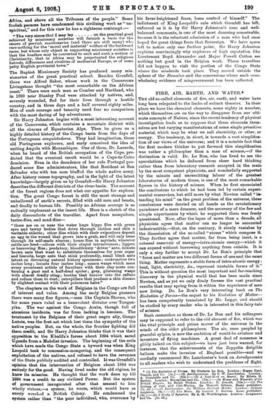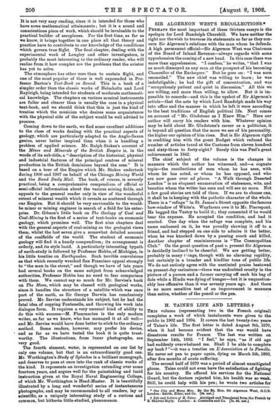FIRE, AIR, EARTH, AND WATER.*
THE old so-called elements of fire, air, earth, and water have long been relegated to the limbo of extinct theories. In their place we have the chemical elements, some eighty in number, which themselves are on the way to disappear from our ulti- mate concepts of Nature, since the recent tendency of physical investigation leads us to suppose that these elements them- selves are but varying manifestations of some single primitive material, which may be what we call electricity, or ether, or energy. The tendency, in short, is towards a vast simplifica- tion of our views of the universe; and it is a notable fact that the first modern thinker to put forward this simplification was rather a philosopher than a man of science,—if the distinction is valid. Dr. Le Bon, who has lived to see the speculations which he deduced from sheer hard thinking rather than from laboratory research accepted in the main by the most competent physicists, and wonderfully supported by the minute and unremitting labour of the greatest laboratories of modern times, is one of the most remarkable figures in the history of science. When he first enunciated the conclusions to which he had been led by certain experi- mental researches, but still more by what Newton called "in- tending his mind" on the great problem of the universe, these conclusions were decried on all hands as the revolutionary Paradoxes of a mere dreamer, and the accuracy of the few and simple experiments by which he supported them was freely questioned. Now, after the lapse of more than a decade, all physicists agree that matter can no longer be amounted indestructible,—that, on the contrary, it slowly vanishes by the dissociation of the so-called " atoms " which compose it. They further agree that matter, far from being inert, is a colossal reservoir of energy—intra-atomic energy—which it can expend without borrowing anything from outside. It is only a step farther to accept Dr. Le Bon's principle that "force and matter are two different forms of one and the same thing. Matter represents a stable form of intra-atomic energy; heat, light, electricity, &c., represent unstable forms of it." This is without question the most important and far-reaching discovery in the physical world that has been made since Newton, and as yet we only dimly foresee the vast practical results that may spring from it within the experience of men now living. Dr. Le Bon's very interesting book on The Evolution of Forces—the sequel to his Evolution of Matter— has been competently translated by Mr. Legge, and should be studied by every reader who is interested in this fairy-tale of science.
Such researches as those of Dr. Le Bon and his colleagues may be supposed to refer to the old element of fire, which was the vital principle and prime mover of the universe in the minds of the older philosophers. The air, once peopled by graceful sylphs, is now the ambition of would-be aviators and inventors of flying machines. A great deal of nonsense is glibly talked on this subject—we have just been warned, for instance, that the achievements of the Zeppelin dirigible balloon make the invasion of England possible—and we cordially recommend Mr. Lanchester's book on Aerodynamics to all readers who wish to understand the problems of flight.
• (1) The Evolution of Foram By Gustave Le Bon. London Kagan Paul, Trench, and Co. [5s.]—(2) Aerodynamics. By F. W. Lauchester. London A. Constable and Co. [21s.]—(8) A Tert-Book on Sound. By Edwin IL Barton. London: Macmillan and Co. [108.]—(4) Min."! and Minerals of the British Empire. By Ralph Stokes. London • E. Arnold. [15e.)—(5) The Geology of Coal and Coal-Mining. By Walcott Gibson. Same publisher. [7s. 641.]—(6) Earth quakes. By William Herbert Hobbs. London : Sydney Appleton. [8s.1—(7) The Moon. By Garrett P. Servisa. Same publisher. [6s.]—(S) A Study of Splashes. By A,. M. Worthington. Loudon Lougmaus and Co. L6s. It is not very easy reading, since it is intended for those who have some mathematical attainments ; but it is a sound and conscientious piece of work, which should be invaluable to the practical builder of aeroplanes. For the first time, as far as we know, it brings together in one place all that theory and practice have to contribute to our knowledge of the conditions which govern true flight. The final chapter, dealing with the experimental work of Langley and other investigators, is probably the most interesting to the ordinary reader, who will realise from it how complex are the problems that the aviator has yet to solve.
The atmosphere has other uses than to sustain flight, and one of the most popular of these is well expounded in Pro- fessor Barton's Text-Book on Sound. This is a book of a simpler order than the classic works of Helmholtz and Lord Rayleigh, being intended for students of moderate mathemati- cal knowledge. The chapters on various musical instruments are fuller and clearer than is usually the case in a physical text-book, and we should think that this is just the kind of treatise which the musician who desires some acquaintance with the physical side of the subject would be well advised to procure.
Coming down to the earth, we find some excellent additions to the class of works dealing with the practical aspects of geology, which are particularly adapted to the Anglo-Saxon genius, never better inspired than when it is handling a problem of applied science. Mr. Ralph Stokes's account of the Mines and Minerals of the British Empire is, in the words of its sub-title, a "description of the historical, physical and industrial features of the principal centres of mineral production in the British dominions beyond the seas." It is based on a tour of the Empire which Mr. Stokes undertook during 1906 and 1907 on behalf of the Chicago _Mining World and the Band Daily Mail. The book, of course, is severely practical, being a comprehensive compendium of official or semi-official information about the various mining fields, and appeals to the general reader only in view of the wonderful extent of mineral wealth which it reveals as scattered through our Empire. But it should be very serviceable to the would- be miner or mining engineer in search of a field for his enter- prise. Dr. Gibson's little book on The Geology of Coal and Coal-Mining is the first of a series of text-books on economic geology, which promises well. The first nine chapters deal with the general aspects of coal-mining as the geologist views them, whilst the last seven give a somewhat detailed account of the coalfields of the world. The student of economic geology will find it a handy compendium; its arrangement is orderly, and its style lucid. A particularly interesting bypath of earth-study is followed by Professor Hobbs, of Michigan, in his little treatise on Earthquakes. Such terrible convulsions as that which recently wrecked San Francisco appeal strongly to "the man in the street," and though we have of late years had several books on the same subject from acknowledged authorities, Professor Hobbs has no need to fear comparison with them. We cannot say so much for Mr. Serviss's book on The Moon, which may be classed with geological works, since it handles the structure of a satellite which was once part of the earth, as Sir George Darwin has conclusively proved. Mr. Serviss understands his subject, but he had the fatal idea of copying Fontenelle, and throwing his work into dialogue form. It requires a very unusual kind of ability to do this with success—M. Flammarion is the only modern writer, as far as we know, who has managed it at all well— and Mr. Serviss would have done better to stick to the ordinary method. Some readers, however, may prefer his device, and as far as we have tested the book it is quite trust- worthy. The illustrations, from lunar photographs, are very good.
The fourth element, water, is represented on our list by only one volume, but that is an extraordinarily good one. Mr. Worthington's Study of Splashes is a brilliant monograph, and deserves to pass at once into the rank of classic works of the kind. It represents an investigation extending over some fourteen years, and argues well for the painstaking and lucid instruction given at the Royal Naval Engineering College, of which Mr. Worthington is Head-Master. It is beautifully illustrated by a long and wonderful series of instantaneous photographs, and may be recommended to all readers, lay or scientific, as a uniquely interesting study of a curious and common, but hitherto little-studied, phenomenon.



































 Previous page
Previous page